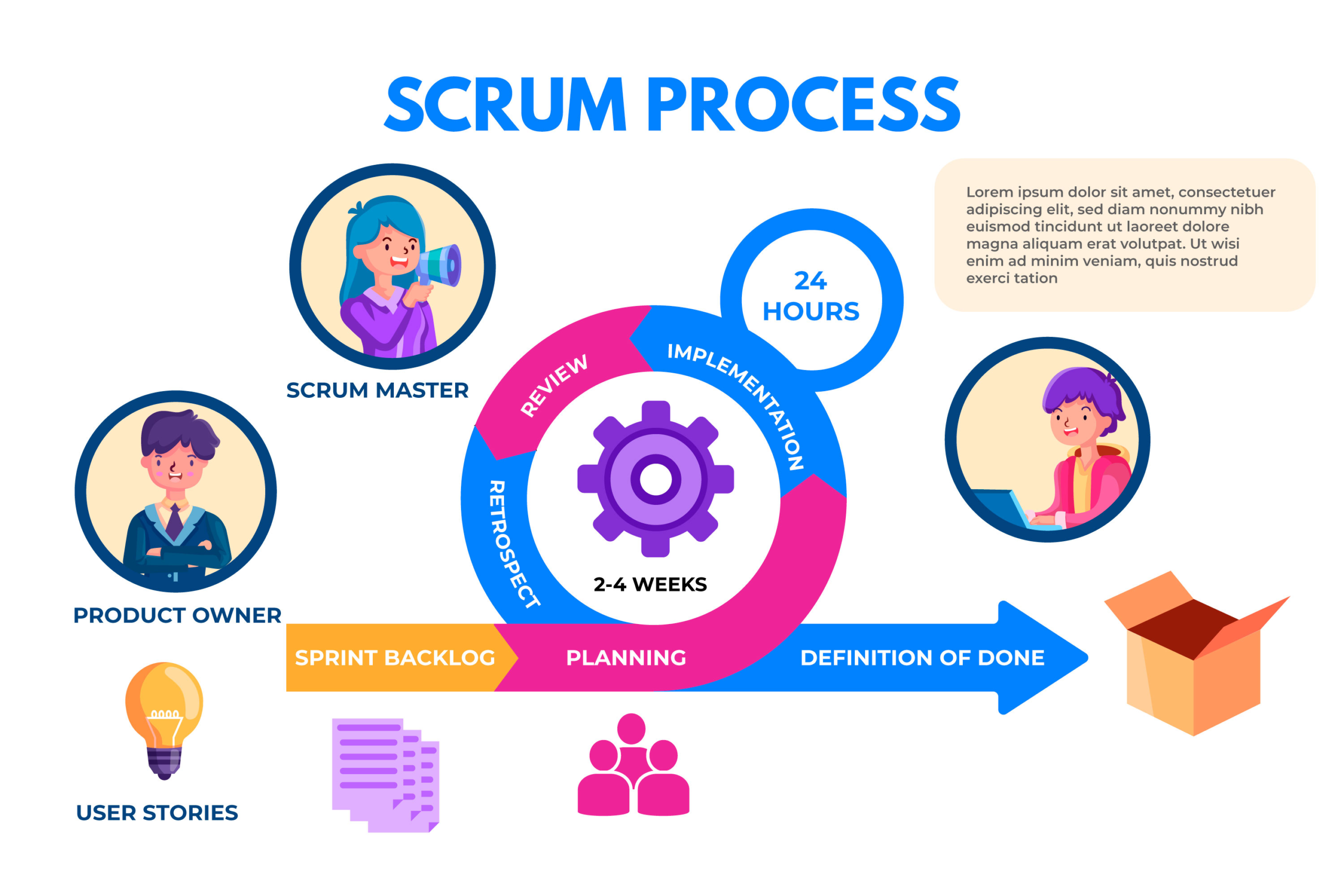In the fast-paced world of modern business, the Agile Methodology has emerged as a game-changer for organizations. Agile practices foster adaptability and collaboration, enabling teams to deliver valuable products efficiently.
In this article, we will delve into the differences and collaborative aspects between two crucial roles in Agile organizations – the Product Owner and the Business Analyst. Understanding the distinctions between these roles is vital for successful project execution and ensuring the delivery of customer-centric solutions.
Scrum Framework Explained
Scrum, an Agile framework, plays a significant role in the development, delivery, and sustenance of complex products. Back in the early 1990s, Jeff Sutherland and Ken Schwaber introduced this powerful approach, which has now been embraced across various industries.
At the heart of Scrum lies its core principles, emphasizing iterative and incremental development. By following this methodology, teams gain the flexibility to adapt swiftly to changing requirements, ultimately enabling them to deliver valuable solutions to customers at a faster pace. Scrum has proven to be a game-changer, fostering efficiency and effectiveness in product development processes.

The Scrum Roles
In the world of Scrum, a “Scrum role” refers to one of the three essential positions that play a pivotal role in the successful implementation of the Scrum framework within a project or organization. These roles are clearly outlined and defined in the Scrum Guide, which is the official and authoritative source for understanding the Scrum methodology.
Product Owner
In Scrum, the Product Owner is the voice of customers and stakeholders, defining the product’s vision to align with business goals and customer needs. They prioritize the product backlog, guiding the development team in creating valuable solutions. Through active collaboration and continuous feedback, the Product Owner ensures project success, meeting customer expectations and achieving business objectives.
Scrum Master
The Scrum Master embodies the essential role of both facilitator and servant-leader within the Scrum team. Their primary responsibility is to ensure a comprehensive grasp and seamless implementation of the Scrum framework, while adeptly eliminating any impediments that may impede the team’s progress. Creating an environment conducive to productivity and collaboration also falls within their purview. Additionally, the Scrum Master assumes the role of a skilled coach, providing valuable guidance to the agile team, and guiding them towards continuous improvement and growth.

Development Team
The Development Team is a self-organizing group of professionals responsible for delivering a potentially releasable product increment at the end of each Sprint. They collectively decide how to achieve the Sprint goals and are cross-functional, meaning they possess all the necessary skills to complete the work.
Product Owners vs. Business Analysts
In the realm of Agile development and product management, two pivotal roles hold significant importance in ensuring successful project delivery: the Product Owner and the Business Analyst. Although both roles are integral to the development process, they encompass distinct responsibilities and areas of expertise. Let’s explore the fundamental disparities between these two roles and grasp their individual contributions.
Definition and Responsibilities of Product Owner
The Product Owner occupies a central and vital position within the Agile team, assuming the role of the customer’s representative and steering the product development process. Close collaboration with the Product Manager enables them to synchronize the product vision with the overarching business objectives.
Among the primary responsibilities of the Product Owner are effectively managing the product backlog, prioritizing user stories, and orchestrating sprint planning. The inherent flexibility of the Product Owner’s role empowers them to adapt seamlessly to the distinct requirements of the organization and the specific project at hand.

Definition and Responsibilities of Business Analyst
The Business Analyst possesses expertise in various aspects of business and product development. They focus on articulating customer requirements and translating them into actionable development tasks. Collaborating with stakeholders, the Business Analyst ensures that projects align with the organization’s objectives and meet customer needs effectively.
Key Differences Between Product Owners and Business Analysts
The Product Owner and Business Analyst undoubtedly represent two distinct and indispensable roles in the Agile development process, each bringing their unique contributions to project success. A comprehensive understanding of the key differences between these roles is paramount for fostering efficient collaboration and ensuring effective project delivery. Let us delve into the primary distinctions between a Product Owner and a Business Analyst:
Strategizing
Product Owner: They strategize for product requirements and business goals, ensuring the team works towards a well-defined vision.
Business Analyst: They strategize for software requirements and user stories, focusing on the technical aspects of product development.
Stages of Project
Product Owner: Manages the product backlog and continuously adapts to changing requirements and market dynamics.
Business Analyst: Records and prioritizes product requirements based on the company’s needs and the project scope.
Analyzing the Product
Product Owner: Maintains the product backlog and takes customer feedback into account to guide development decisions.
Business Analyst: Assists the Product Owner in providing solutions and ensuring that the product meets the customer’s expectations.

Creating Customer Perspectives
Product Owner: They understand customer needs and suggest product features that resonate with the target audience.
Business Analyst: They evaluate customer requirements and user stories to provide insights that add value to the final product.
End Goal
Product Owner: Ensures that the product is developed correctly from a technical standpoint.
Business Analyst: Assesses the market value of the product and suggests necessary changes to meet business objectives.
Making Changes
Product Owner: Reacts to market trends and customer feedback to make iterative improvements to the product.
Business Analyst: Analyzes the system’s progress and ensures compliance with the defined requirements.

Product Owner and Business Analyst Similarities
While the Product Owners and Business Analysts have distinct roles, there are overlapping responsibilities and collaborative teamwork between them. Both roles focus on achieving a common project vision and successful product release. The importance of close collaboration cannot be overstated, as it leads to the delivery of high-value products that meet customer expectations.
Collaboration between Product Owner and Business Analyst
Effective collaboration between the Product Owner and the Business Analyst is critical for project success. Beyond technical expertise, considering personality traits and soft skills when defining these roles ensures a harmonious working relationship. Recognizing the value of diverse perspectives enriches the decision-making process and leads to innovative solutions.
Choosing Between Product Owner vs. Business Analyst
Selecting between the roles of Product Owner and Business Analyst represents a critical decision influenced by your interests, skill set, career aspirations, and work environment preferences. While both roles make substantial contributions to project success, they diverge in terms of responsibilities and required competencies. Consider the following factors when making your decision:

Product Owner
Strategic Vision: If you enjoy defining the strategic vision of a product, setting priorities, and making decisions that impact the entire product lifecycle, the role of a Product Owner might be the right fit for you.
Customer Focus: Product Owners are the voice of the customer and stakeholders. If you thrive on understanding customer needs, gathering feedback, and creating customer-centric solutions, this role might align with your interests.
Leadership and Ownership: Product Owners have ownership of the product backlog and are accountable for the product’s success. If you are comfortable taking on leadership responsibilities and guiding the development team, this role offers an opportunity for growth.
Business Acumen: Strong business acumen is essential for a Product Owner, as they need to balance market demands, business goals, and technical feasibility to create a successful product.
Business Analyst:
Detailed Analysis: If you enjoy diving into the details of business processes, gathering and analyzing requirements, and creating comprehensive documentation, the role of a Business Analyst might be a good fit.
Communication and Collaboration: Business Analysts work closely with stakeholders, development teams, and subject matter experts. If you excel at communication and enjoy collaborating with various team members, this role offers ample opportunities.
Problem–Solving: Business Analysts often deal with complex business challenges and find solutions that meet both business and user needs. If you are skilled at problem-solving and enjoy finding creative solutions, this role might be rewarding.
Flexibility and Adaptability: Business Analysts work across different projects and industries. If you prefer a diverse and varied work environment that involves continuous learning, this role can provide that.
Consider Your Career Goals:
Think about your long-term career goals and how each role aligns with them. Consider whether you want to pursue a more technical career path within the development team (Business Analysts) or a leadership role with a strategic focus (Product Owner).

Explore Your Interests and Seek Professional Growth
Take a moment to reflect on your interests and the aspects of the development process that ignite your passion. Are you drawn to the prospect of closely collaborating with customers, molding the product’s vision as a Product Owner? Or do you find gratification in delving into business processes, meticulously defining detailed requirements as a Business Analyst?
Moreover, contemplate the abundant opportunities for professional growth and advancement within each role. Conduct thorough research on the potential career paths, certifications, and training options offered in both fields.
Remember, there is no definitive right or wrong choice between the roles of Product Owner and Business Analyst. Each role holds its own value and significantly contributes to project success. The key lies in comprehending your strengths, interests, and aspirations, guiding you toward a decision that harmonizes best with your professional journey. If feasible, seek exposure to both roles through internships, projects, or job shadowing, allowing firsthand experience to inform your well-informed choice.

Conclusion
In conclusion, the roles of Product Owner and Business Analyst are essential pillars of the Agile development process. Understanding the key differences between these roles enables organizations to harness their complementary strengths effectively. Collaboration between these roles is pivotal for delivering successful projects and valuable products. As businesses continue to embrace Agile methodologies, the Product Owner and Business Analyst will continue to play pivotal roles in shaping the future of software development and Agile organizations.
FAQs
How should BA and PO work together?
The Business Analyst (BA) and Product Owner (PO) should collaborate closely throughout the project. The BA can assist the PO in gathering detailed requirements from stakeholders and translating them into user stories. This collaboration ensures that the development team has a clear understanding of the business needs and user expectations. The BA’s analytical skills complement the PO’s strategic vision, resulting in a well-defined product backlog. Open communication, mutual respect, and a shared focus on delivering customer value are essential for effective teamwork between the BA and PO.
What is the role of BA in Product Owner?
The role of the Business Analyst (BA) in the Product Owner (PO) team is to support the PO in understanding and documenting detailed business requirements. The BA conducts in-depth interviews with stakeholders, performs requirement analysis, and creates clear and actionable specifications. By collaborating with stakeholders and end-users, the BA ensures that the PO’s product vision aligns with business needs. The BA’s contribution helps the PO prioritize the product backlog effectively and ensures the development team has the necessary information to deliver valuable product increments.
Can a business analyst become a Product Owner?
Yes, a Business Analyst (BA) can transition into a Product Owner (PO) role, as both roles share some overlapping skills. BAs often have experience in gathering requirements, analyzing user needs, and understanding business processes, which are valuable skills for a PO. To make the transition, the BA should develop additional competencies, such as strategic thinking, customer focus, and product vision. Building leadership abilities and enhancing communication skills will also help the BA thrive in the PO role, where they will be responsible for driving the product’s success and collaborating with stakeholders.
Is a BA a Scrum Master?
No, a Business Analyst (BA) is not the same as a Scrum Master. These are distinct roles in the Agile methodology. The BA is responsible for gathering and analyzing business requirements, translating them into detailed specifications, and ensuring alignment with project goals. On the other hand, the Scrum Master is a facilitator and servant-leader for the Scrum team. Their focus is on ensuring the team understands and follows the Scrum framework, removing impediments, and fostering a collaborative work environment. While both roles contribute to project success, they have different responsibilities and skill sets.



